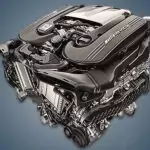The 3.0-liter inline 5-cylinder Mercedes OM 617 engine was assembled from 1974 to 1990 and installed on such popular models as the W123, W126 or Geländewagen SUV. This diesel unit has been constantly upgraded, so it has several modifications.
The diesel R5-family includes: OM617, OM602, OM605, OM612, OM647.
In 1974, a similar 5-cylinder engine was created on the basis of the OM616 4-cylinder diesel engine. The first modification of this pre-chamber diesel power unit was atmospheric. It has the same cast-iron cylinder block, a cast-iron 10-valve cylinder head without hydraulic lifters and a two-row timing chain that rotates both a single camshaft and an in-line Bosch M injection pump. In 1979, a new cylinder head appeared, the compression ratio was raised and power increased from 80 to 88 hp.
In 1977, the Garrett TB03 turbocharged diesel debuted on the American version of the W116 sedan. In 1979, it was also modernized and the power of the new unit increased from 111 to 121 hp. In 1982, the engine was updated again and the most powerful modification appeared with 125 hp and 250 Nm.
OM617 is considered one of the most reliable engines, often reaching over 1,000,000 km, which is one of the key reasons for Mercedes’ popularity in North America in the 1980s.
The turbocharged engine was the first diesel engine suitable for use in S-class and mid-range cars. Daimler-Benz was interested in meeting the fuel consumption targets set by the US government. This is how the 300 SD (S-Class Diesel) and 300 CD (Coupe Diesel) models appeared, the first (S-Class W 116, Coupe C 123) and the second body version (S-Class 126 series).
Specifications
| Production years | 1974-1990 |
| Displacement, cc | 3005 (OM 617 D 30 (1974), OM 617 D 30 A (1977) 2998 (OM 617 D 30 (1979), OM 617 D 30 A (1979), OM 617 D 30 A (1982) |
| Fuel system | vortex chamber |
| Power output, hp | 80 (D30 (1974) 88 (D30A (1977) 111 (D30 (1979) 121 (D30A (1979) 125 (D30A (1982) |
| Torque output, Nm | 172 (D30 (1974) 172 (D30A (1977) 228 (D30 (1979) 230 (D30A (1979) 250 (D30A (1982) |
| Cylinder block | cast iron R5 |
| Block head | cast iron 10v |
| Cylinder bore, mm | 91 (D30 (1974), D30A (1977) 90.9 (D30 (1979), D30A (1979), D30A (1982) |
| Piston stroke, mm | 92.4 |
| Compression ratio | 21.0 (D30 (1974) 21.5 (D30A (1977), D30 (1979), D30A (1979), D30A (1982) |
| Hydraulic lifters | no |
| Timing drive | double-row chain |
| Recommended engine oil | 10W-40, MB 228.1/229.1 |
| Engine oil capacity, liter | 6.5 |
| Fuel type | diesel |
| Euro standards | EURO 0 |
| Fuel consumption, L/100 km (for Mercedes 300 SD 1978) — city — highway — combined |
11.2 8.7 9.9 |
| Engine lifespan, km | ~1 000 000 |
| Weight, kg | 265 |
The engine was installed on:
- Mercedes E-Class W114 in 1974 – 1976; E-Class W123 in 1976 – 1986;
- Mercedes G-Class W460 in 1979 – 1990;
- Mercedes S-Class W116 in 1977 – 1980; S-Class W126 in 1979 – 1985;
- Mercedes T1-Series W601 in 1981 – 1988.
Disadvantages of the OM617 engine
- Diesel engines until 1979 often had cracks in the block in the region of the fifth cylinder and the crankshaft burst. There was a constructive miscalculation, which was corrected a little later.
- The turbine here does not have a large resource and does not tolerate when the engine is turned off immediately after a long drive at high speed. In general, it is better to install a turbo timer.
- This motor is equipped with a very powerful, but not the most durable double-row timing chain. About once every 200 – 250 thousand km it needs to be changed along with dampers and stars.
- Also, the owners of such diesel engines complain about very noisy operation, strong vibrations and frequent lubricant leaks, especially through the crankshaft rear oil seal, which is stuffed here. It should also be noted that the booster pump is not the most reliable, it often leaks.





